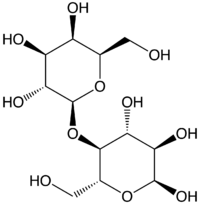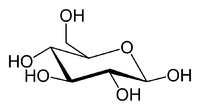(9 am. – promoted by ek hornbeck)
This is likely to be a hotly debated essay. The subject of High Fructose Corn Sweetener (HFCS) is extremely controversial, with a spectrum of advocates ranging from those who articulate that is nothing but poison in any amount, to those who articulate that is nothing but safe. I believe that the truth is somewhere in the middle.
We will examine first the chemistry of sugars, then the use of added sugars in processed foods, then some of the political and economic causes, and finally have an open forum. I hope that everyone will contribute.
First, some housekeeping. I STILL have not bought cigarettes since March. That Prince Albert is awfully good, though, but I still smoke fewer of them than I did the nonfilter Camels because I actually have to get up and roll one.
The second is an observation about the economy. I set out to buy a new business suit today, since I have applied for work and want to look good for any interview. I have lost quite a bit of weight in the past year or so, and a suit too large just looks unprofessional. Initially I was going to drive to Lexington to visit Joseph A. Bank and the Men’s Wearhouse, but buying a suit there would entail a second trip to Lexington after alterations to take possession of the suit in question, and each one is about a 60 mile round trip, so I decided to shop locally.
The shopping mall here is Richmond is not the largest in the world, but it has (or had, as the story turns out) several men’s clothing stores and a J.C. Penney, so suits should be available. Thus, I went there. The mall is essentially closed. The only stores left open are a couple of jewelery ones (rich folks still can buy things), two out of eight or nine food court ones, the movie theatre (the only one in town), the military recuiting station, Sears (the one here always sold only appliances and tools), a couple of hair salons, a discount furniture store (where the Goody’s, a bankrupt chain used to be) and Claire’s. I kid you not.
J.C. Penney is gone. Just gone. I bought bedsheets when I first moved here in 2004, and it was a large store. Even the Dollar Tree is gone. All of the clothing stores are gone, along with everything else except for what I mentioned. I was astounded as I walked the mall, and counted. Walking it, and using fingers as an abacus, for every ten store entrances, four were dark and locked. That is right, 80% of the stores in the mall here are out of business. This is not a good thing.
Anyway, to the scientific issue at hand, High Fructose Corn Sweetener (HFCS). This a material created by Big Agriculture to replace cane or beet sugar in many, in not most, consumer products. This is not your grandmum’s Karo Light Syrup, also called corn syrup. This is a very different material, designed to go head to head with sucrose (cane or beet sugar) in sweetening prepared foods and soft drinks.
First, let us review what these sugars actually are. Sucrose, common table sugar, is a disaccharide composed of a glucose (aka dextrose) molecule bound with a fructose molecule by the elimination of a single molecule of water. Such reactions are called either condensations (because two become one) or dehydrations (because the two become one with removal of a single molecule of water). I prefer the latter term, if one remembers that two molecules are condensed into one.
This leads into the idea about monosaccharides and disccaccherides. A monosaccheride is essentially an organic molecule with five of six carbons (usually six) in a skeleton with a five or six membered ring. They are very simple (in biochemistry) molecules, and are food for almost everything, including us. The most important one, for us humans, is glucose, the fuel that runs our bodies. Glucose is the currency of life, and without enough of it, or with the inability to process it properly, we just simply die. That is what diabetes is, the inability to process glucose properly for cellular energy. Without proper amounts of the hormone insulin, the ability to transport glucose across the cell membranes is lost, and the body dies from lack of energy conversion. That is Type I (juvenile) diabetes.
Cells in the pancreas, (technically the beta cells in the islets of Langerhans, named after the person who discovered those islets) produce insulin through an extremely complex feedback mechanism and regulate glucose levels in the blood in a very tight range in normal folks. For some reason, and some sort of autoimmune ailment is strongly implicated, those beta cells are attacked by the patient’s own body and destroyed. The result is that it is impossible to regulate glucose metabolism. This has several effects, and none of them are good.
First, energy decreases because the food that cells need is not readily available to them. Second, glucose concentrates in the blood, and the kidneys are put in overdrive to try to get it to normal levels. Normal urination becomes rampant urination, and water intake has to be increased to assist the kidneys in washing out the glucose. That leads to depletion of plasma ions, so that sodium, potassium, calcium, and chloride becomes depleted as well. Most young folks actually die from mineral imbalance than from long term damage.
Fortunately, insulin injection can control this condition very well, and newer technology has been introduced that actually measures the glucose level in the blood and automatically increases or decreases the amount of insulin delivered. This is a technological replacement for the feedback system that nondiabetics have.
Another kind of diabetes, Type II (adult-onset, a misnomer) diabetes results when cells become resistant to the action insulin. The causes for Type II diabetes are not well known, but it is strongly linked to obesity. There are two strategies (in addition to diet control and weight loss) to treat it. In one, drugs that stimulate the beta cells to produce more insulin are given. In the seconds, drugs that increase the sensitivity for insulin in the cells. Often these drugs are given together. However, insulin production usually decreases over the years and insulin supplements are often required. Keep these facts in mind as we continue.
Now, the sugars that we most often encounter are sucrose, lactose, glucose, fructose, and galactose. Sucrose, table sugar from cane or beets, is familiar to everone. It is a disaccharide formed from one glucose and one fructose molecule. Lactose is also a disaccharide fromed from one glucose and one galactose molecule. Many people have trouble digesting lactose, hence lactose intolerance. Here are diagrams for each of these:

Sucrose

Lactose

Glucose

Fructose

Galactose
Thus, sucrose is a 50/50 mixture by weight of glucose and fructose, bound chemically. In the body, the enzyme sucrase acts as a catalyst to add a water across the bond between the two molecules, forming one molecule of glucose and one of fructose. The sugars enter the portal vein and go to the liver. Glucose is little metabolized by the liver and enters the general circulation. Fructose is heavily metabolized by the liver, and eventually is converted to glucose through many intermediates.
High fructose corn sweetener comes in several versions, the most common ones being 45/55 (HFCS-55) glucose to fructose and a 58/42 (HFCS-42) one. The latter is used in processed foods and bakery items, whilst the former one is primarily used to sweeten soft drinks. The main point is that there is very little difference between the ratio of glucose to fructose in HFCS-55 and cane sugar, so you get very little more fructose in HFCS sweetened soft drinks and cane sugar sweetened ones. The main difference is that in cane sugar you get sucrose that you digest to the 50/50 mixture, whereas in the case of HFCS-55 that digestion step is unnecessary, thus a faster rise in blood glucose levels can occur since that step is no longer necessary.
Those of you familiar with the corn industry will say, but Doc, field corn does not have any sugar in it to speak of (in contrast to sweet corn, the kind that we eat as a vegetable), but starch, and starch is composed of glucose molecules only. You are correct. The starch is hydrolyzed to form glucose syrup (this is grandma’s Karo Light Corn Syrup), then the glucose syrup is enzymatically treated to convert some of the glucose to fructose. The reason is that fructose is sweeter than glucose, so an equal amount of HFCS-55 is much sweeter tasting than glucose syrup, being almost identical in sweetening ability to cane sugar.
There are many reports about how bad HFCS is for people, and I really do not think that the science is there to support it. For example, let us look at things universally accepted to be good for us. These data are for a 100g portion, and are taken from the USDA database, so I am not just making up numbers here.
100g of apples, with peel, contain 2.07 g sucrose (which is 50/50 glucose to fructose), 2.43 grams free glucose, and 5.90 grams fructose. When you add the gram that you get from the sucrose after digestion, that comes to 3.46 g glucose and 6.94 g fructose. That comes to 33/67, of what amounts to HFCS-67! But no one tells you not to eat apples.
How about that new health food craze, pomegranate juice? 100 grams of it has no sucrose, 6.28 grams of glucose, and 6.37 grams of fructose. This comes to almost exactly 50/50, corresponding to HFCS-50. Yet no one rails about how bad this is for you.
OK, two poor guesses. Let us try one at random, say, blueberries (another health food craze lately). 100 grams of raw blueberries have 0.11 grams sucrose, 4.88 grams glucose, and 4.97 grams fructose. That is equivalent to HFCS-50 as well.
How about the old standby, orange juice? 100g of orange juice from concentrate contains 3.50 g sucrose, 2.34 g glucose, and 2.56 g fructose. Neglecting the sucrose, that comes to the equivalent of HFCS-52!
So it is hard for me to buy the story that HFCS-55 is “unnatural”. Many of the fruits that we eat are very similar, so that dog does not hunt. Here is what I think is going on here. Twelve ounces of that orange juice has 168 calories. Reading from the label of the world’s most popular soft drink, that same 12 ounces has 140 calories, with a similar glucose to fructose profile. However, the orange juice also has 708 mg of potassium, 145 mg Vitamin C (240% of your recommended minimum daily) along with many other trace vitamins and other nutrients. The cola does have some caffeine in it though. (The USDA database does not address that specific product for some reason). The bottom line is that the soft drink is devoid of all nutrition except for calories.
Now, let us carry this further. I know very few people who drink even 12 ounces of orange juice every day, usually more like eight ounces, for 112 calories and still lots of nutrients. Many of those same folks will drink four or five soft drinks per day, say four for sake of argument, for a total of 560 calories, or over one-quarter of the standard daily 2,000 calorie diet and NO NUTRIENTS. By the way, that also amounts to 52% of the recommended daily intake of carbohydrates and still NO NUTRIENTS.
For a little more perspective, let us assume that cane sugar was used to sweeten the soft drink because everyone is familiar with it. Those four cans total 156 grams, or 5.5 ounces of sugar,, over a third of a POUND!. At that rate, if you were just to eat the sugar with a spoon, a five pound bag of sugar would last you just two weeks. This is not counting all the other sugar that you ingest over the course of the day.
My considered opinion is that it the the quantity, and not the identity, of the sugar that is bad for you. We did not evolve on such high sugar diets. That is recent development. But you say, Doc, they used to use honey for a sweetener. Yes, they did, but the honey supply even today is a very small fraction of sugar and HFCS production. Speaking of honey, it has to be better for you than HFCS, right? Well, 100 g of honey has 1,272 calories, 0.89 g of sucrose, 35.75 g of glucose, and 40.94 g of fructose, the equivalent of, neglecting the little sucrose, HFCS-53, almost identical to the HFCS-55 used to sweeten soft drink! The honey has a traces of vitamins and minerals, but not enough to count for anything.
Well, why use HFCS as all? Why not just use sugar instead? There is a practical reason and a very perverse one, and we pay for the latter. The practical reason is that HFCS-55, as a syrup, is easier to blend that granulated sugar to make the concentrate for soft drinks, since the sugar is already dissolved.
The second reason is twofold. First, the United States heavily subsidizes the corn industry. This makes the source material relatively inexpensive, the energy costs are not radically different than producing sugar from cane or beets. Second, the United States imposes a tariff on imported sugar to boost the US price. I will looking at futures figures a bit ago, and the US price for sugar futures to be delivered in August is 23.20 cents per pound. The world price for sugar is 18.61 cents for September delivery. This does not seem like a big deal, but with sweetener being the largest ingredient in soft drinks, after water, a 25% price differential is huge. HFCS-55 can do the job for less than the US price for sugar. The perverse part is that the US taxpayer actually provides the funds to make HFCS more attractive to business than sugar.
There have been lots of clinical studies done, and I have reviewed many of them. From what I can tell, there is not any definitive study that unequivocally shows that HFCS have much of an effect on people that is different than regular sugar. Some of the studies are not very good, and it is hard to find control subjects that do not use any HFCS at all. For example, my loaf of 100% Whole Wheat bread (a store brand from one of the largest chains in the US) is made with HCFS instead of sugar. So are some frozen dinner roll dough balls that I have. Unless you use no processed foods at all, it is likely that you are consuming HFCS. Thus, carefully controlled studies are difficult at best.
My advice is, if you like a cola, have one every now and then, but not every day and certainly not four or five a day. Try to get good nutrition, even though there may be a little HFCS in it. Eat fresh fruits and vegetables, even those those fruits might as well have been sweetened with HFCS. The problem is not that there is HFCS here and there, but we as a society just eat too much, and even worse, too much of things that are not good for us. The obesity rate is not increasing because of HFCS, it is increasing because we are eating more and exercising less. Before anyone gets the wrong idea, I am in general a detractor of Big Agriculture I think that in general they have too much political power and too much control over the things that we eat. However, I think that we should use better arguments against them that the hooey about HFCS being poison.
Well, you have done it again. You just wasted another perfectly good batch of electrons reading this nonsense. And even though Jim DeMint wants President Obama to succeed when he reads me say it, I always learn much more than I could possibly hope to teach by writing these essays. Please keep those questions, comments, corrections, and any other technical issue coming.
WOW! The rec list. Thanks!
UPDATE: WOW! Front paged! Thanks, Ek!
Warmest regards,
Doc
Crossposted at Dailykos.com

9 comments
Skip to comment form
Author
Warmest regards,
Doc
just by cutting out sweets, allowing myself the once in a while treat and not eating junk/fast food. Did not even change my other eating or cooking habits.
I figure I can lose another 10 by increasing my exercise and looking at portion size and changing some of my meal prep. Now when you are over 40 it is $%^&* harder.
I now see that I was making myself feel terrible by picking up fast food while driving into work.Yes, I am a health care provider and we are the worst offenders. I work nights so if I forgot to cook there was no other choice or so I told myself. And I don’t miss it either. Giving up the sweets was much harder but they have those 100 calorie snacks now that allow me to indulge without over doing it.
I also more or less see that I was uncomfortable with my body and hiding it by dressing strategically ( mind you most women my age have to do that anyway) and while I do think that everybody probably has a body weight they naturally end up hitting, most of us won’t be a size 4, and there is nothing wrong with being over the “ideal” weight as long as you feel comfortable with yourself. Comfortable in your own skin which I was not.
Somewhere between the no body fat look of Madonna and the rise of generalized obesity is where we need to be hitting.
One thing that also disturbs me. I do watch TV sometimes and it struck me one night that MOST of the commercials were about food. Extorting people to snack, promoting giant portions at fast food outlets while of course showing thin people having a good time. It was actually fairly creepy when I started paying attention. Americas fast food pushers and crappy snack makers do want us to be hooked and to be compliant little consumers.